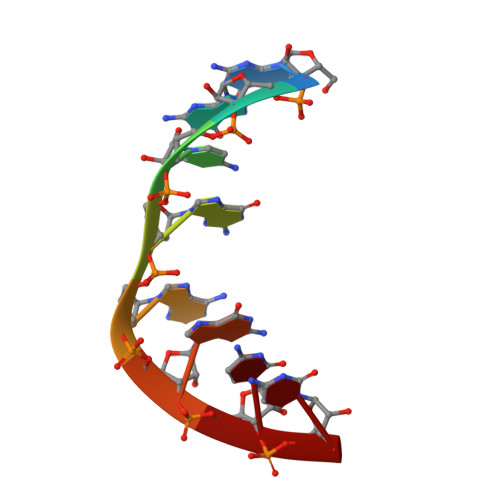Structure of (rGGCGAGCC)2 in solution from NMR and restrained molecular dynamics.
SantaLucia Jr., J., Turner, D.H.(1993) Biochemistry 32: 12612-12623
- PubMed: 8251479
- DOI: https://doi.org/10.1021/bi00210a009
- Primary Citation of Related Structures:
1YFV - PubMed Abstract:
The duplex (rGGCGAGCC)2 contains tandem G x A mismatches--a common motif in the secondary structures of biological RNAs. The three-dimensional structure of (rGGCGAGCC)2 was derived using molecular dynamics and energy minimization with NMR-derived restraints for 78 interproton distances (per strand), 18 hydrogen bonds for the six Watson-Crick G x C pairs, and 26 dihedral angles (per strand). The G x A mismatch structures are similar to those observed in a DNA duplex [Li, Y., Zon, G., & Wilson, W. D. (1991) Proc. Natl. Acad. Sci. U.S.A. 80, 26-30] and an RNA hairpin [Heus, H. A., & Pardi, A. (1991) Science 253, 191-193], with hydrogen bonds from guanine 2-amino and N3 to adenine N7 and 6-amino, respectively. The other G 2-amino and A 6-amino protons are within hydrogen-bonding distance of a phosphate oxygen and 2'-oxygen, respectively. Strong interstrand A-A and G-G stacking is observed between the G x A mismatches. This contrasts with the poor stacking observed between the G x A mismatches and closing G x C base pairs. The stems are basically A-form with all bases in the anti conformation and all nonterminal sugars in the C3'-endo conformation. The structure rationalizes previous thermodynamic, circular dichroism, and imino proton NMR results and suggests tandem G x A mismatches in RNA may provide a contact site for tertiary interactions.
- Department of Chemistry, University of California, Berkeley 94720.
Organizational Affiliation:
















